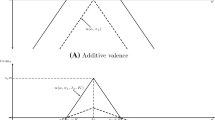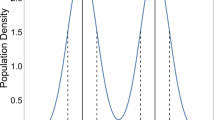Abstract
This paper offers graphic illustration of so-called “valence” models of candidates responding to their perceptions of voter location in a two-party system. Models by Groseclose and others show how the combination of candidate uncertainty about the median voter location, nonzero candidate valence, and policy motivated candidates leads to departures from the median voter prediction. With one policy dimension, either there exists an equilibrium where the candidates do not converge to the median (or any other common position) or there exists no equilibrium. We offer illustrations based on plausible conditions. Under some conditions we show an equilibrium where candidates locate at separate policy positions. Under others, we illustrate the absence of equilibrium.
Similar content being viewed by others
References
Adams, J. F., Merrill, S., & Grofman, B. (2005). A unified theory of party competition. New York: Cambridge University Press.
Alvarez, M. (1997). Information and elections. Ann Arbor: University of Michigan Press.
Ansolabehere, S. D., & Snyder, J. M. (2000). Valence politics and equilibrium in spatial election models. Public Choice, 03, 327–336.
Aragones, E., & Palfrey, T. R. (2002). Mixed equilibrium in a Downsian model with a favored candidate. Journal of Economic Theory, 103, 131–161.
Bruter, M., & Harrison, S. (2007). United Kingdom. In Y. Deloye & M. Bruter (Eds.), Encyclopaedia of European elections. Basingstoke: Palgrave Macmillan.
Calvert, R. L. (1985). Robustness of the multidimensional voting model: candidate motivations, uncertainty, and convergence. American Journal of Political Science, 29, 69–95.
Downs, A. (1957). An economic theory of democracy. New York: Harper & Row.
Enelow, J., & Hinich, M. (1984). The spatial theory of voting. New York: Cambridge University Press.
Erikson, R. S., & Romero, D. R. (1990). Candidate equilibrium and the behavioral model of the vote. American Political Science Review, 84(December), 1103–1125.
Groseclose, T. (2001). A model of candidate location when one candidate has a valence advantage. American Journal of Political Science, 45(October), 862–886.
Londregon, J., & Romer, T. (1993). Polarization, incumbency, and the personal vote. In W. A. Barnett, M. Hinich & N. Schofield (Eds.), Political economy: institutions, competition, and representation. New York: Cambridge University Press.
McCarty, N., Poole, K., & Rosenthal, H. (2006). Polarized America. Cambridge: MIT Press.
Nahin, P. J. (2007). Chases and escapes: the mathematics of pursuit and evasion. Princeton: Princeton University Press.
Schofield, N. (2004). Equilibrium in the spatial valence model of politics. Journal of Theoretical Politics, 16, 447–481.
Strom, K. (1990). A behavioral theory of competitive political parties. American Journal of Political Science, 34(2), 565–598.
Wittman, D. (1983). Candidate motivation: a synthesis of alternatives. American Political Science Review, 77, 142–57.
Wittman, D. (1990). Spatial strategies when candidates have policy preferences. In M. Hinich & J. Enelow (Eds.), Advances in the spatial theory of voting. Cambridge: Cambridge University Press.
Author information
Authors and Affiliations
Corresponding author
Rights and permissions
About this article
Cite this article
Bruter, M., Erikson, R.S. & Strauss, A.B. Uncertain candidates, valence, and the dynamics of candidate position-taking. Public Choice 144, 153–168 (2010). https://doi.org/10.1007/s11127-009-9509-9
Received:
Accepted:
Published:
Issue Date:
DOI: https://doi.org/10.1007/s11127-009-9509-9




